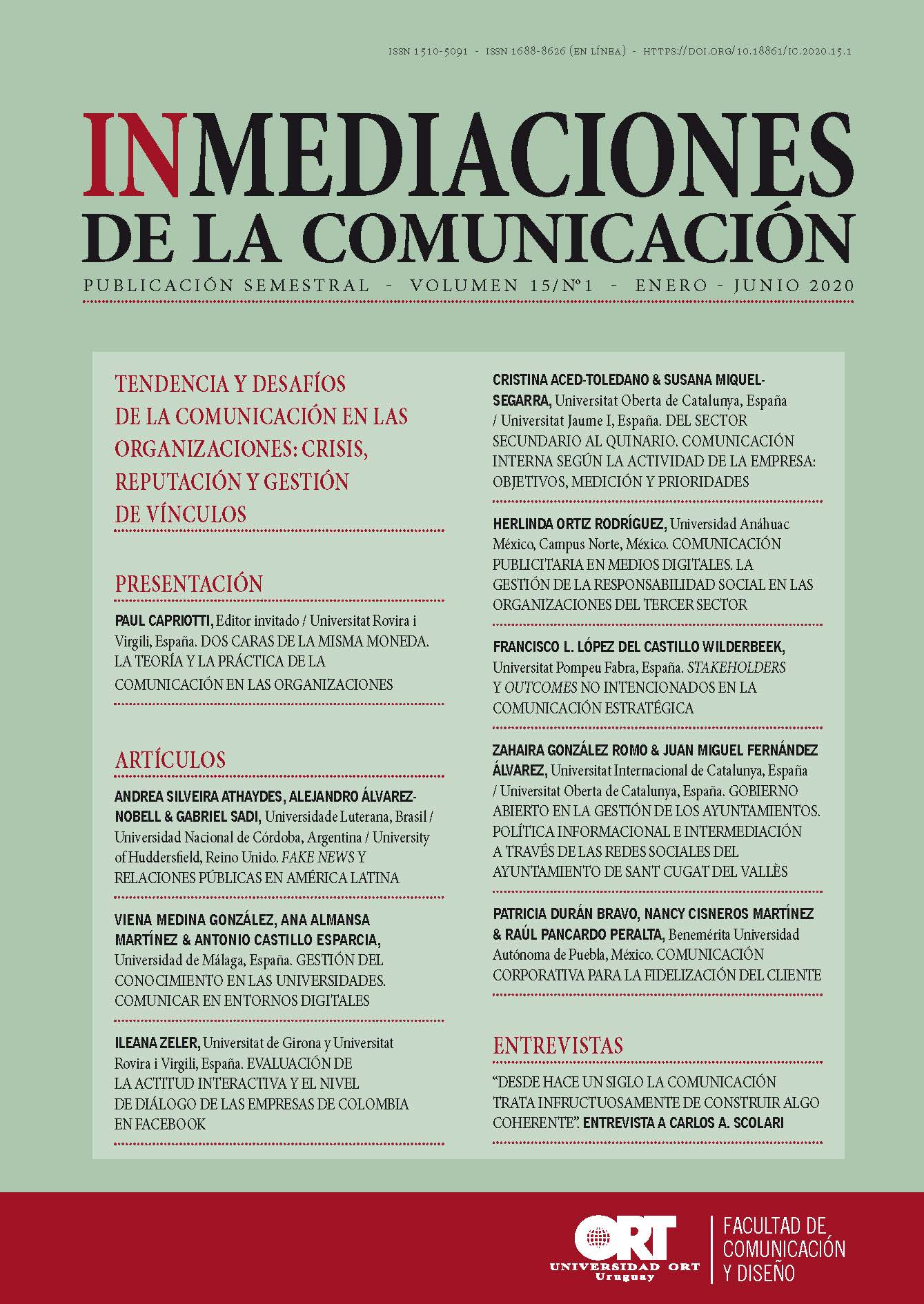Fake news and public relations in Latin America
DOI:
https://doi.org/10.18861/ic.2020.15.1.2956Keywords:
Latin America, strategic communication, fake news, Latin American Communication Monitor, public relationsAbstract
The phenomenon of fake news has been one of the main themes in the 2018-2019 edition of the Latin American Communication Monitor, the largest study on the profession of public relations and strategic communication carried out by the European Public Relations Education and Research Association (EUPRERA). Through a comparative study in the different countries of the region, the results characterize the development of the activity, the structures and the main trends from the professionals’ perspective. On this occasion we present, with 1,165 responses considered valid, and within a target audience profile, the main results linked to fake news in the public relations activity in Latin America. Although professionals are accompanying discussions about this phenomenon (more than 60%), only 26% of organizations have already implemented formal guidelines and routines to deal with fake news and only 7.2% have specific technologies and systems installed to identify them. Government organizations (which claim to be the most affected: 37.2%) and those that have already been affected by this type of practices (49.7%) are those that rely on the individual competencies of their communication structure to solve the problem.
Downloads
References
Bakir, V. & Mcstay, A. (2017). Fake News and The Economy of Emotions. Digital Journalism. DOI: http://dx.doi.org/10.1080/21670811.2017.1345645
Brummette, J., Distaso, M., Vafeiadis, M. & Messner, M. (2018). Read All About It: The Politicization of “Fake News” on Twitter. Journalism & Mass Communication Quarterly, 95(2), 497-517.
Edelman (2018). Edelman trust barometer. Global report. New York: Edelman.
Falkheimer, J. & Heide, M. (2018). Strategic communication. London: Routledge.
Guo, L. & Vargo, C. (2018). Fake News and Emerging Online Media Ecosystem: An Integrated Intermedia Agenda-Setting Analysis of the 2016 U.S. Presidential Election. Communication Research. DOI: 10.1177/0093650218777177
Holtzhausen, D. & Zerfass, A. (Eds.) (2015). The Routledge handbook of strategic communication. New York: Routledge.
Hou, J. (2017). It’s your business to combat fake news: A manager’s guide to protecting your business. Auckland: Massey University. Available on: http:// bit.ly/ecm2018ref7
Macnamara, J. (2018). A review of new evaluation models for strategic communication: Progress and gaps. International Journal of Strategic Communication, 12(2), 180-195.
Macnamara, J., Lwin, M. O., Adi, A. & Zerfass, A. (2017). Asia-Pacific Communication Monitor 2017/18. Strategic challenges, social media and professional capabilities – Results of a survey in 22 countries. Hong Kong: APACD.
Macnamara, J., Lwin, M. O., Adi, A. & Zerfass. (2015). Asia-Pacific Communication Monitor 2015/16. The state of strategic communication and public relations in a region of rapid growth. Survey results from 23 countries. Hong Kong: APACD.
Meng, J., Reber, B. H., Berger, B. K. & Gower, K. (2019). North American Communication Monitor 2018: Tracking trends in fake news, issues management, leadershipperformance, workstress, social media skills, job satisfaction and work environment. Results of a survey of 1,020 communication professionals in the U.S.A and Canada. Tuscaloosa: The Plank Center for Leadership in Public Relations.
Moreno, A., Molleda, J. C., Álvarez Nobell, A. Herrera, M., Athaydes, A. & Suárez, A. M. (2019). Comunicación estratégica y sus retos: fake news, confianza, información para la toma de decisiones, liderazgo y compromiso laboral. Resultados de una encuesta en 19 países. Bruselas-Madrid: EUPRERA/DIRCOM.
Moreno, A., Molleda, J. C., Athaydes, A. & Suárez, A. M. (2015). Latin American Communication Monitor 2015. Excelencia en comunicación estratégica, trabajo en la era digital, social media y profesionalización. Resultados de una encuesta en 18 países. Bruselas: EUPRERA.
Moreno, A., Molleda, J. C., Athaydes, A., Suárez, A. M. & Álvarez Nobell, A. (2017). Latin American Communication Monitor 2016-2017. Tendencias en comunicación estratégica: big data, automatización, engagement, influencers, couching y competencias. Resultados de una encuesta en 17 países. Madrid: EUPRERA/DIRCOM.
Nothhaft, H., Verčič, D., Werder, K. P. & Zerfass, A. (Eds.) (2018). Future directions of strategic communication. International Journal of Strategic Communication, 12(4), 329-332.
Organización de Estados Americanos (2017). Declaración Conjunta sobre Libertad de Expresión y "Noticias Falsas", Desinformación y Propaganda, 2017. Recuperado de: http://www.oas.org/es/cidh/expresion/showarticle.asp?artID=1056&lID=2
Tandoc, E. C. Jr., Lim, Z. W. & Ling, R. (2018). Defining “Fake News”. Digital Journalism, 6(2), 137-133.
Yonck, R. (2017). Heart of the Machine: Our Future in a World of Emotional Artificial Intelligence. New York/NY: Arcade Publishing.
Zerfass, A., Tench, R., Verhoeven, P., Vercic, D. & Moreno, Á. (2018). European Communication Monitor 2018. Strategic communication and the challenges of fake news, trust, leadership, work stress and job satisfaction. Results of a survey in 48 countries. Brussels: EACD/EUPRERA - Quadriga Media Berlin.
Published
Versions
- 2020-09-07 (2)
- 2020-06-09 (1)
How to Cite
Issue
Section
License
Copyright (c) 2020 InMediaciones de la Comunicación

This work is licensed under a Creative Commons Attribution 4.0 International License.





